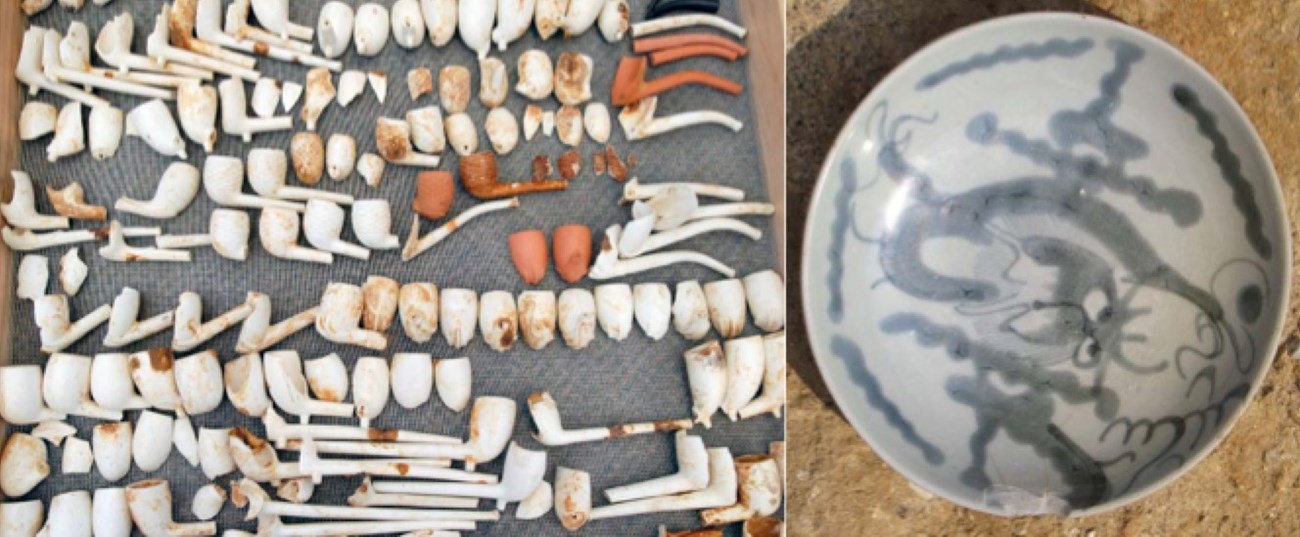Last updated: March 6, 2023
Article
Memory and Truth: Excavating “Liberty” at the President’s House

NPS photo
when the sample contained only 20th century construction debris?
Over the next four months of excavation at the President’s House site, archeologists got their answer. The site’s power lay not in the foundation walls, bits of broken bottles and ceramic dishes, or deep wells they discovered. Rather it was the power of the space itself, the memories embedded in it, and the cry of stories needing and demanding to be told that drew in thousands of visitors to the site each day.
These narratives illustrate the “historical hypocrisy” of freedom and enslavement that the President’s House site embodies (Jeppson, Roberts, Brauer, and Levin in Mooney et al., 98). The now-demolished first home at 190 High Street was built in 1767 by Mary Lawrence Masters, widow of William Masters—the former mayor of Philadelphia and the city’s largest slave holder. Later occupants included their daughter and son-in-law William Penn (grandson of Pennsylvania’s founder), Generals William Howe and Benedict Arnold, and Robert Morris (a signer of the Declaration of Independence). However, the High Street property’s most famous residents were Presidents George Washington and John Adams, who lived there with their families and servants (free and enslaved in Washington’s case, free only in Adams’s) from 1790-1797 and 1797-1800 respectively.

NPS photo
Archeological excavations uncovered and explored the spaces where Ona Judge, Hercules, the seven other enslaved individuals, the staff of indentured and wage-earning servants, and the Washingtons themselves worked and slept every day. Because the site is in the middle of downtown Philadelphia, it contains many layers of urban debris. As they excavated deeper in the ground, archeologists moved back in time to finally reach the 18th-century foundations and surfaces they sought. Four significant finds were discovered: the stone foundation walls of the original President’s house, the bow window (a large extension with curved walls installed by Washington that was the inspiration for the oval rooms within the modern White House), the kitchen/washhouse root cellar, and an underground passageway between the kitchen and the main house. The latter two areas were especially important in telling all of the stories of the President’s House. These areas were not documented in historical records and it was within them that free and indentured servants and enslaved individuals performed the everyday tasks that allowed the President’s households to function. Yet these confined, “invisible” spaces further confined and hid these people (and by extension the institution of slavery) from the eyes of Washington’s guests. The kitchen itself was a mere seven feet from the formal bow window room, yet the “immeasurable distance between freedom and slavery” divided them (LaRoche 2007 as cited in Mooney et. al, 101).

NPS photo
Source: Jeppson, Douglas Mooney et al. The Archeology of Freedom and Slavery: Excavations at the President’s House Site in Philadelphia. Prepared for the National Park Service and City of Philadelphia. URS Corporation, National Park Service, and Independence National Historical Park, 2009.
Resources
Video: Excavating a Well at the President’s House.
Lawler, Edward, Jr. “The President’s House in Philadelphia: The Rediscovery of a Lost Landmark.” The Pennsylvania Magazine of History and Biography 126 (January):5-96. 2002.
Oney Judge’s Escape to Freedom. National Park Service.
The President’s House: Freedom and Slavery in the Making of a New Nation. City of Philadelphia.
President's House Site: Uncovering the Past through Archeology. National Park Service.
Tags
- independence national historical park
- archaeology
- archeology
- presidents
- presidential history
- president of the united states
- excavation
- 18th century
- george washington
- john adams
- northeast region
- philadelphia
- pennsylvania
- east coast
- house
- african american
- american revolution
- american history
- black history
